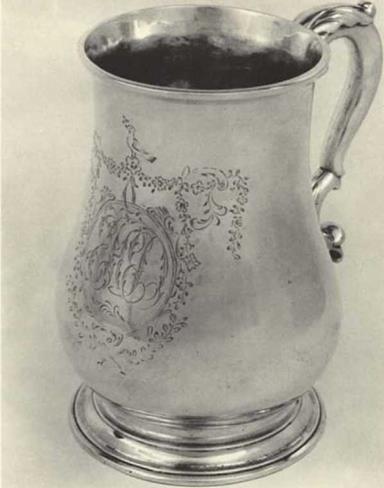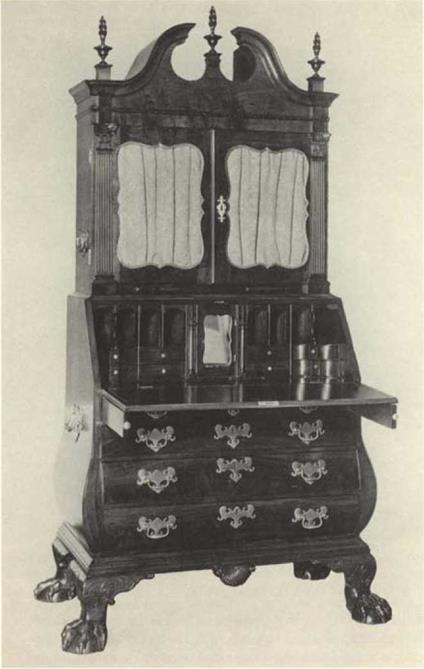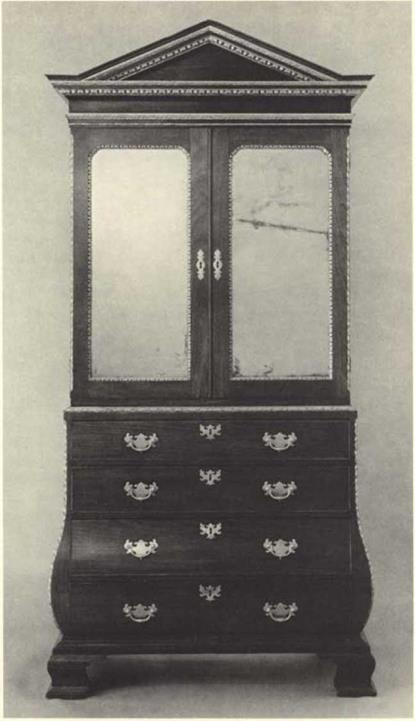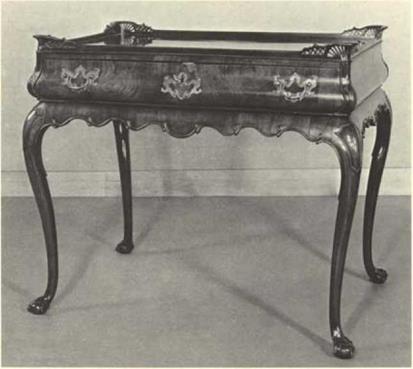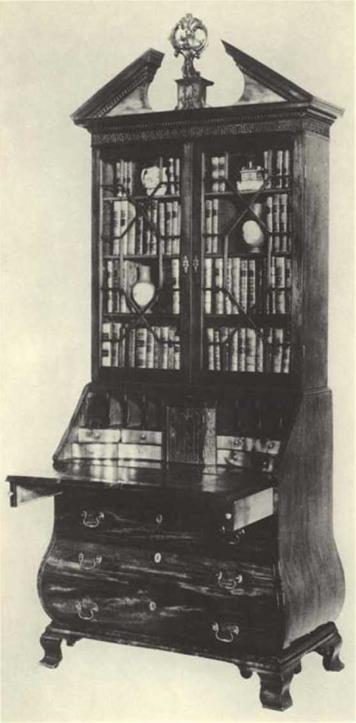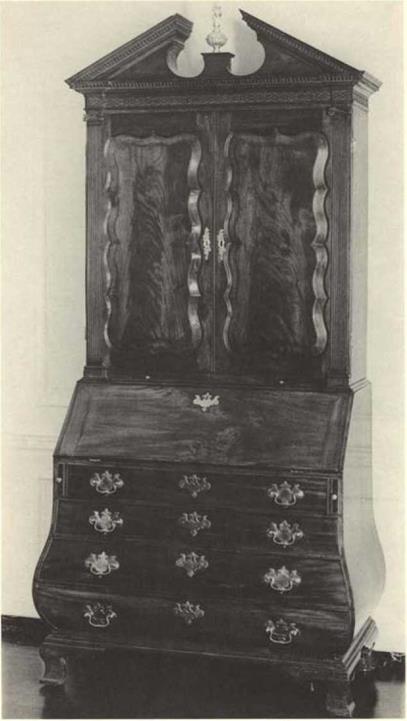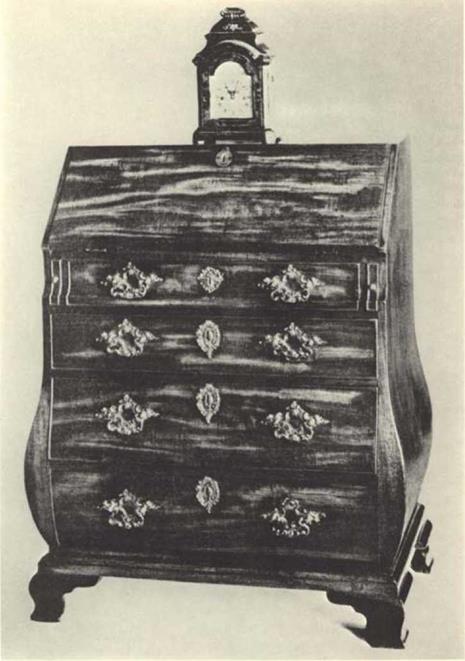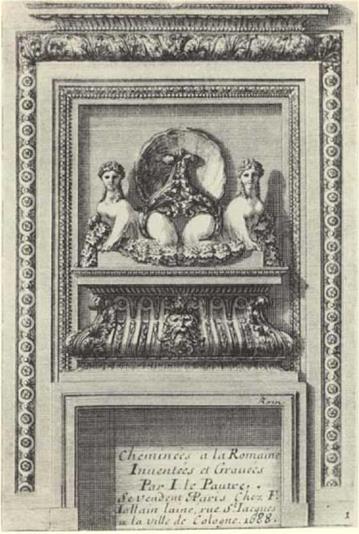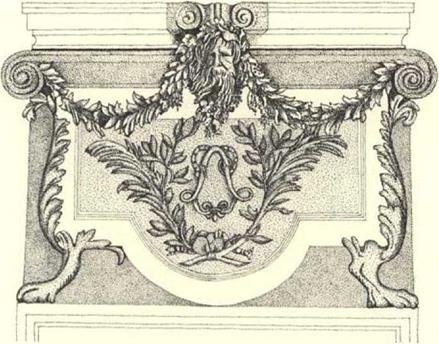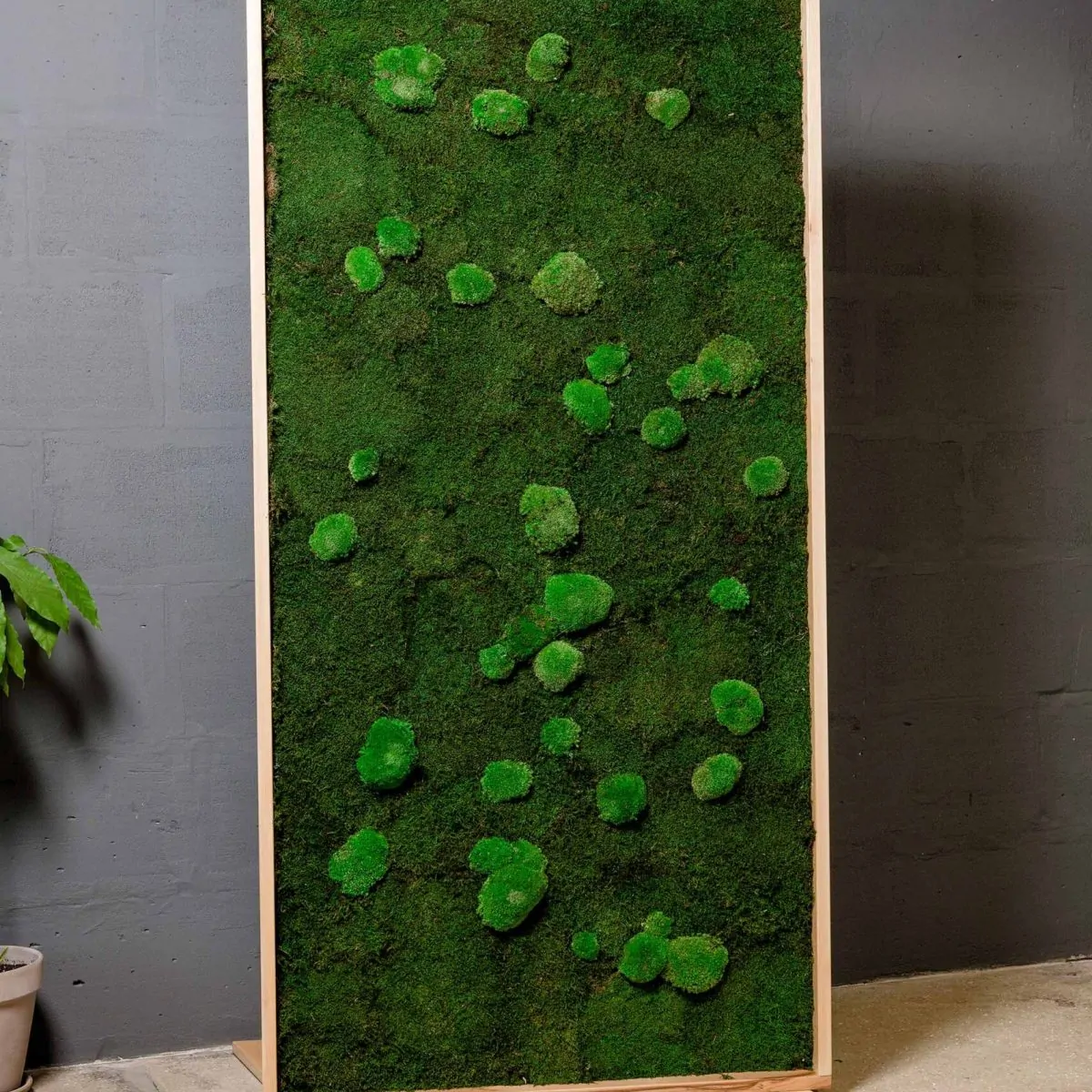The sources oi American bombf furniture present a complex problem. The first native manifestation of Bostonians’ taste for the curvilinear baroque style is found in silver. With its easy transportability, inherent value, and strong dependence on Continental design, silver
4. Desmond Rlr-GcTald, Geetfran Furniture (London, 1969), fig. 11.
5. Chippendale ііїо imported French furniiure; Edward Joy in an anicle in Country Lift, ex (Avgitsi. 19Ji), j*j, draws intciuion то Chippendale’s шешрт io avoid ihe English customs.
145
was probably the vehicle for much of the importation of current English taste in die seventeenth and eighteenth centuries. In the 1650s jolui Hull and Robert Sanderson produced a caudle cup that has virtually the identical shape as the later bombe furniture (fig, 99). The same bombd form—often called “tulip-shape’—continued to be used in such silver objects as teapots, coffee pots, milk pots, and casters throughout the eighteenth century. Perhaps die greatest popularity of the form was achieved in can ns and tankards. Indeed, the mlip-shaped cami may be considered one of the distinct marks of Boston silver just as the bombJ cascpiccc is of Boston furniture. The parallel appeal of the form in iwo mediums is substantiated by Elias
 9Й. Disicn foil a Tall Clock. From Thomas Chippendale, Тік Crttilrman <md СаЫпп – Malctrs Director, plate cxjucv. London, 1754. (The Henry Francis du Pont WiiiTenhur Museum Libraries.)
9Й. Disicn foil a Tall Clock. From Thomas Chippendale, Тік Crttilrman <md СаЫпп – Malctrs Director, plate cxjucv. London, 1754. (The Henry Francis du Pont WiiiTenhur Museum Libraries.)
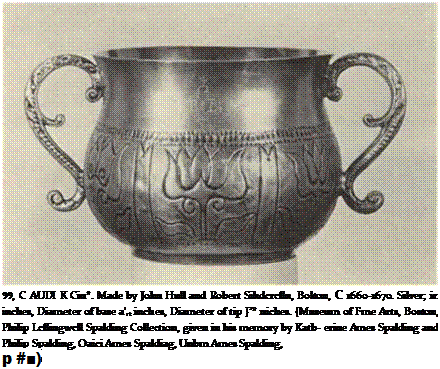
Haskct Derby’s purchase rtf two tulip-shaped canns from Paul Revere in 17S3, one year after Cogswell completed the Derby chest-on – chest (fig. 100).
The popularity of the silver form seems trt show the partiality of Bostonians to die shape but cannot be viewed as die direct source of inspiration for its use in furniture. The dose similarity between American and English bom be furniture indicates a more probable source. Til rough the tics of immigration, trade, and government, England dominated colonial culture. Despite the various types of furniture upon which the bombd form was used, there remains a pervasive adherence in Boston to a single interpretation ofbomb^ design that lias a direct counterpart in English furniture dating as early as die
|
|
іООгСлки. Миіе by Paul Revere, Hastern, 1783, Siker; и. 6 у, inches, [The Metropolis)] Museum of Леї, purchase, 19$B, SinJibury-M]|[s FutufJ This сапп M originally turned by Elias Hashes Dtrby (17J9-1799J of Salem.
mid-1720s.6 Eng (and produced a myriad of bombd forms, yet Boston steadfastly produced only one type. The lack of invention may indicate a single source or a number of very similar sources for the
6a The London cabinetmaker Samuel Bennett labelled a bombe desk and bookcase (c. 1720) that is illustrated in Percy Macquoid and Ralph Edwards., The Dictionary 0/ English Furniture, 2nd cd_. rev,, j vok (London, 1954), lp 13,6.
|
|
101. Dtsx AMD SuuicASf. Made by Janie* McMiliian, Boston, c, 17+5-1765, Mahogany and white pine; II. 56 inches, W. 51 inches (before restoration). (Present location mi known. Sold it the American Art Association auction of the estate of Francis Shaw, December 12—]+, 193 j, lor 472. Kestored and sold again at the American An Association auction of the estate of Albert S. Hill. March 12, 193 3, lot 100: photo (before restoration), Decorative Arts Photographic Collection. The Henry Francis du Pont Winterthur Museum.)
Boston patron and cabinetmaker to follow. More likely, it shows the essentially provincial nature of the Boston cultural milieu; Bostonians did not feel sufficiently secure to venture into new, inventive designs but, in the nature of a colonial society, selected, simplified, repeated, and perfected design motifs from the mother country.
Why Boston should have chosen only this design for the bombd shape is difficult to determine. There is the possibility that an English bombe casepiccc of this design was imported to Boston by an in – ffnential person. By such means tire form could have quickly acquired the symbolic aura of established social and economic stature that it seems to have enjoyed.
Possibly an English design book provided the source for the bomb^ furniture of Boston. Chippendale1* Direct# offers a direct prototype. The publication is known to have been available in Boston and all editions contain a number of designs that would offer a simple solution to the question of a source (for example, fig. yti). However, since Frothingham constructed a bomb£ desk and bookcase a year preceding the publication of the first edition, the stimulus for the ЬошЫ form had appeared before the first possible pictorial source. Chippendale is thought to have published designs that were currently in vogue in London; the pieces of furniture that he illustrates were probably made by himself and other cabinetmakers before and after publication.
Thus, Frothingham probably imitated a bomb£ casepiccc already in Boston, Either a London-trained cabinetmaker could have immigrated to Boston and produced an "American" bombd or an English casepiccc could have been imported. At this date, a cabinetmaker fitting the necessary qualifications has yet to be identified; the only documented American bomb£ casepiccc known that could predate the Frothingham desk is a desk and bookcase made by James Me – Mi Ilian (fig. юі), McMiilian was probably bom in Salem and worked in Boston between 1749 and 1769. However, it is unlikely that his desk and bookcase, an unusual example with enormous paw feet, served as the source for Frothingham. More likely, a piece of imported English furniture introduced the bombe form to Frothingham and die rest of Boston.
One English example, a bomb£ chest-on-chest made about 1740, has a tradition of ownership by Charles Apthorp (1698-1758) of Boston (fig. 102). His inventory lists "a Mohogotiy Bcauro with Glass doors" in the great parlor and "a Mohogony Cabinet with glass doors" in the upstairs dining room;[55] [56] either description could refer to the chest. Characterized as the "greatest and most noble merchant on the continent" at his death,** Apthorp would have given social stature to the new form.
The Apthorp chest may well have been the direct means by which the bombtf form reached and became accepted in boston. The external appearance has the identical boinb^ shape and use of straight drawer sides found in the Frothingham desk, Tn respect to overall design, Frothingham displayed a more powerful sense of baroque movement through the use of the swan’s ncch pediment. The English chest, distinctly architectural in design, relates to Palladia» architecture and the furniture designs of William Kent with elaborate, almost oversized detailing and a heavy pedimented top. The similarity of the bo tube base with that of Frothingham’s desk, if it cannot prove the seminal importance of the Apthorp chest, certainly reinforces the theory of the English background of the bombtf form as found in Boston. The construction of the lower sections of the pieces of furniture is identical. The differences in overall design and standard of finish are more striking, but are not unusual in any comparison of eighteenth-century Boston and London cabinet making. The chest has very fine dovetails, not found in boston furniture until the nineteenth century; the secondary woods are finely cut oak and deal rather titan white pine, duslboards are solid and the back is panelled rather than boarded.
Another example of European bomb£ furniture with a history of Boston ownership is a desk and bookcase made in the Netherlands about 1740 and said to have been owned by Governor Thomas
|
|
102. Chest-oh-Ck£!T. England, c, 1740-17s#. Mahogany, oak. and deal; H. 97 inches, w, 46^ inches, n. ajVi inches, (Museum of Fine Arts. Boston. Gift of Albert Sick, 1971.717.) Aeeordittg to family tradition, this dust was owned by Charles Apthorp (|ДО-І£5Л), a wealthy metdsant of Boston, and way have been the "Mahogany Beaurp with GUtt doors" listed in the tjsS inventory of the foments of his King Street house.
Hutchinson (1711-1780) (fig, 103},9 The furniture of a royal governor was necessarily impressive and as the governor’s household would probably have been on view to most of the influential colonists, a new form of furniture introduced by the governor might be expected to have an impact on local taste and design, hi addition. Governor Hutchinson, who belonged to one of the oldest Massachusetts families, lived in one of the handsomest houses in Boston,10 Nonetheless, this desk and bookcase had virtually no direct impact on Boston bombe furniture. The presence of the bomb£ form has something of the same spirit found in Boston, but there the similarity ends. The construction of the Dutch desk has no counterpart in Boston cabinctmaking: the bombf form is contained within two bulges on the front of the piece of furniture; the sides are flat; the entire surface is veneered; and comer posts join the sides and the front rails—a feature never found in Boston cabinetwork. The interior construction of Dutch furniture is also quite different from that of Boston, with secondary’ woods often pieced together and roughly finished and drawers nailed together rather than dovetailed. The squat, heavy proportions and exuberant multiple curves characterizing Dutch furniture are also unrelated to the linear proportion of Boston furniture. The Netherlands is often considered a possible source for American ЬошЫ furniture, but the comparison of construction and proportion show’s that there is actually very little direct connection between die cabinctmaking traditions.
English bombd design of the eighteenth century may have served as the inspiration for many craftsmen in Europe as well as in Boston. In a tea table (fig, 104) diat lias been considered one of the finest examples of eighteenth-century Dutch furniture.11 the ЬотЫ design is relared to the same tradition found in America, despite the typical Dutch emphasis on the comers. If indeed the table were made in the Netherlands, die simplified line and subdued curve arc still
9, Jubcpli W. P. Frost, "Living with Antiques, Peppcrrefl Minsinn, Kinery Point, Maine," Antiques, lxxxix (Mirth, ipto), 370Ю, Abbott Lowell Cum mint’s. "The Foster-Hutchinson Hfluie," ОШ-Time S’tur Fngiwd, LtV (WilllCT, 1964), J9-76-
11. World Furniture, ed. Helmi Hiywird {London, 1965), p. 167.
|
|
103, Desk asd Bookcase. The Nctherlmds, c. 1740-1730. Walnut. (Collection of Mr. Jjmri W. P. Frotf: photo, Antiijvf!,) Aiiording Ip family tradition, ihil dalle was owned by Thomas Hulthinsem (17J i-iy8o), true of the last royalgovernors ejMassachusetts.
|
104. T ел Table. The Netherlands, c. 1745-1755. Walnut; n. Jt*/j inches, Sv. j8l* inches. n, 25% inches. (RijksnmseuTn, Amsterdam.) |
profoundly English. The cross-exchange of furniture, designs, and craftsmen between England and the Netherlands became very complex in die seventeenth and eighteenth centuries. Dutch construction and bom be design seem to have had 11 tile influence on English cabinetmakers. But. so little is known about Anglo-Dutch furniture design that further research is necessary before any conclusive analysis can be reached.
The career of the German Abraham Roentgen [1711-1793), founder of the famous cabinetmaking firm located in Neuweid near Cologne, bears out the theory of English importance in the development of the bombe form in northern Europe. In his bom be furniture
|
|
105, Disk and Bookcase. England or Ireland, c. 1750-1770. Mihog – iny. (Present [oration unknown. Illustrated m F, Lewis Hinckley, A Directory cf Queen Лнггг. Early Gfuryifm and Chippendale Eumiture |New York, i97i]< P’ 244: photo, C 1971 by F. Lewis Hinckley. Used by permission of Crown Publishers, Ine.)
|
|
106, Desk and Bookcase. Boston, c. i7/io-i7*>o. Mahogany and white pine; h. 102% inches. 4/. 48% inches, D. I}1,. inch», (The Department of State, Washington, D. C.) Affording to family tradition, this desk and boakease descended in the Hamad; family of Boston,
Rerentgen used the same contour that the Boston cabinetmakers borrowed from London. Roentgen worked in Loudon between 1731 and 17}8,,г started the cabinctmaking business in Neuweid in 17JO, and sent one of bis assistants to be trained in London and to return with an English apprentice. The eminence attached to English cabinet making was demonstrated by his son, David Roentgen, who called himself an English cabinetmaker although he had never been tn England.
English dominance of Boston design can be seen by comparing an English desk and bookcase (fig. 105) with a Boston example (fig, 106). The strong similarity of design between the two desks is immediately evident. In external appear ante the English desk could have been made in Boston (except for the door and entablature fretwork and the rococo cartouche, which is more reminiscent of Philadelphia work). Another close resemblance is found in an English desk (fig. 107) and an American desk (fig, 108). which is stamped by G. Cade and which descended in the nineteenth century in the Sylvan us Plympton family of Woburn, Massachusetts.’^ The proportions of the two desks are different because of die addition of a fifth drawer in the English example, but the bombe form is much the same in both eases.
The bombd form was popular during the same period in England, Germany, and Boston. Erorhingham was constructing his bombe desk and bookcase when Roentgen began to produce similar cx-
lj. Hans HurH, "Roenigem—Cabuict-Mjlccij," Th r Соляоі’неиг, xctl (A up им,
103 J),
ij. For in illustration of (hr Cade brand, ке Аігмтігип Antiqutt from hrot) Sudr Collritiw, і vnij. (Washington, D.C., 19*)}. it, J40- “G, САПЕ" may refer 10 George Cade (i715M7#0), a Boston ropemaker, or! o his son. George Cade, Jr. (before 17^9— 1B0J), also a local rope maker. The younger Cade’s inventory included "t Old Desk" valued at S2.00. If, in fact. Cade did own the bombe desk, [Hen it probably pissed [O the Plympton family soon after his death in іАод. An inscription on [He desk read*. "Augusta P. Plympton. Decr[?j 27 iSjO j Formerly property uf Dr. Plympton, Waban." For further information oh the Cade and Plympton families, see Suffolk probate Heeordj, dockets 19402, 12J90; A Rrport of iht Retord Commissioners of Ihe City <f liojfort. Catfartlinjj Ihe Sfotistirs cf the LrmW Safes’ Dirrrt Far of 170$. As Assessed in ЛіоМп, XXII (btrstort, l Эр!,), 72, 306, ;|Ві; John Adams Vinton, Fire KrrA*- atdsoП Memorial (Portland, Maine, 1И7Л), p. 272.
amples- In 1761 Queen Charlotte of Eng Sand ordered a borabd secretary from William Vile, the recently appointed cabinetmaker to George ІП (fig, J09). The invoice in the accounts of St. James’s Palace describes die newly delivered piece of furniture as "an exceedingly flmc mahogy secretary with drawers and з w л ting drawer, a sett of shelves at Top, and the sides and back all handsome eutt – woгk.’’[■, It cost.£71. When the Society of Upholsterers and Cabinetmakers of London published the second edition of Genteel Household Fuтіште in the Present Taste about 1762. they included designs for a bombe clothes press, clothes chest, and pedestal, all employing the form popular in Boston.[57] [58]
Froth ingham’s creation of a bombi cascpicce in 1753 demonstrates that Boston taste was concurrent with the London vogue. Boston’s colonial status i$ reflected in tile rclaiivc simplicity of decoration, in the repetition of the same form without change, and in the acceptance of this form with all its social import over nearly hal fa century. The persistent popularity of one furniture design indicates a certain cohesivcncss of outlook in the Boston area. Boston was still a relatively small town iti the eighteenth century; the confrontation of new, non-English cultural influences in the nineteenth century was still far otf! Nor had the new political freedom obtained by die Revolution found expression in cultural life except in the most tentative manner.
Although England was the direct source for Boston bombrf furniture, the form was not indigenous to the English sense ofdcsign. The interest in the classical past engendered by the Renaissance led to the imitation of Roman sources in Italian furniture. The medieval chest or cassette was brought up to date by incorporating the forms of Roman sarcophagi that often included curvilinear designs closely associated with eighteenth-century bombe furniture. The development of the baroque aesthetic reinforced and aggrandized the bomb£ character of Renaissance cassatti. Bombe chests spread throughout
|
|
107. Г)еїї. Ungbnd, с. 1740-1700, Mahogany. (Present location unknown. Illustrated in H. A vray Tipping, English Furniture of the Cabriole Period (London, fjijJ, plate 111: photo. The Henry Franeii du Pont Winterthur Museum Libraries,)
|
|
108. Dfjjt. Stamped "G. CADE" (probably the name of ал owner). Boston, c. 1755— t77j. Mahogany and white pine; U. 42% inches, w. 45% inches, d, ij1/* inches. (The Hennage Collection; photo, Israel Sads. Ire.. New York City.) See also figs. 119 and 120. їііі 1iesk was probably ou’twd in the early nineteenth century by George Cade, Jr, (before 1 769- lAjj), a Boston ropemaker, and later passed into the Plymplonfoinify ef Woburn, Massachusetts,
Europe. lb By the mid-seventeenth century, picturesque ensembles in the baroque style incorporating the bom be form in chimney pieces, door surrounds, altars, tabernacles, memorials, and pedestals were published in France (fig. no). In the 1680s the painrer-desigiier – architccr Charles Lebrun (1619-1690) designed a direct prototype of [59]
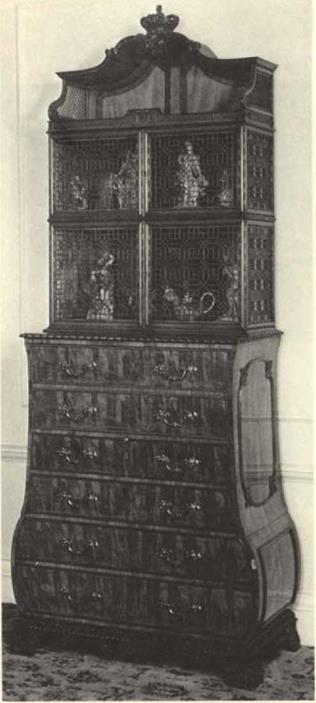 109. Secretary. Made by William Vile. London, іубі. Mahogany and thuja wood; n, S4 inches, w. 37 inches, D. it! inches. (Buckingham Palace: photo by gracious permission of Her Majesty the Queen,) Tiiis saMary utas coastrutttd fat Quern Charlottc of England.
109. Secretary. Made by William Vile. London, іубі. Mahogany and thuja wood; n, S4 inches, w. 37 inches, D. it! inches. (Buckingham Palace: photo by gracious permission of Her Majesty the Queen,) Tiiis saMary utas coastrutttd fat Quern Charlottc of England.
|
|
110. DfsrchL Гой л СнімМЕї Piece. From Jean LePauire, ChtmitiJci а І4І Rttmdbu, plate!, Paris, I(SSS, (The Henry Frincisdu Pont Winterthur Museum Libraries.}
the first bombi5 casepicces in the bas-rdicf over the doors of die Salon dc la Guerre at Versailles (fig. 111].17
The progenitors of the eighteenth-century bomb£ casepiccc were built by the Trench cabinetmaker Andr^-Charlcs Uoulle (1642-1732}.
17- For photographs of the bas-relief in the SaJon de la Guerre, see Aiutnd Pcnte, VtTfaitlti: Lc Cfj. rfrarr, Les Jardin, Ltf Trian<m, Lr Miufr, La faille (Paris, tOOj}, pp. 39. 41; Key Monuments of the History of Architecture, cd – Hairy А. МШсиі (Englewood СШ&* New Jersey, and New York, 1964), p. 402.
|
ttt. OvsnDooB Detau.. By Chiles Lc flrun зЫ Anioinc Coysevox, Salon dt h Guerre, Versailles, c. i6Sa-ifiSj. (Drawing by Corinne Pascoe.) |
In 1708 and 1709 he constructed a pair ofbomb£ commodes for die King’s bedroom at the Trianon in thcFark of Versailles (fig. 112),18 die earliest examples ofcasepiecei with drawers in the bomb£ form. The novelty of the commodes lay in the use of drawers extending across the entire width of the chest ami sliding into the frame. Although awkwardly suspending a sarcophagus pendant from a flat – topped table (botli forms retain four legs), the design is an attempt to make the Italian ccissotte into a more functional and permanent piece of furniture. It was probably the designer Jean Beraiti (1638-1711)
l£. Vicrtc Veilct, French Royal Furniture (London, i9<Sj), p. S.
who supplied die resolution to the new design in his Omemerts InvtgttZ par J, Retain, published in Paris about 1710. Be rain’s successful unification of the tier of drawers and the supporting legs established the primary model for all eighteenth-century bomb* cascpieces (fig, 111).
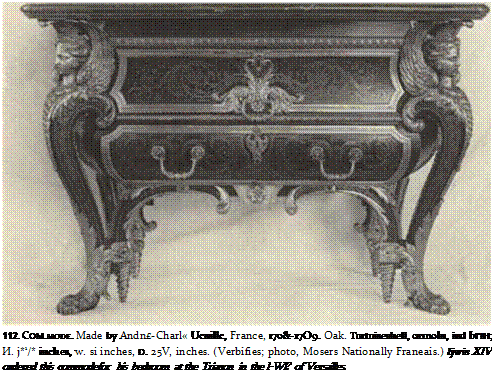
The anglieiiation of the commode can be seen by comparing a later French commode in the tradition of Rouilc (fig, 114) with a bom be chest of drawers made in England (fig. 115). Although the English example shows the indigenous propensity for a natural wood finish rather than the ornate pritniere-parlte inlay and ormolu decoration traditional in French cabinetwork, die underlying design of both casepicccs is die same. The full English attainment which developed from this somewhat awkward attempt at the assimilation
165
of the bomb£ form is seen in [he secretary by William Vile (fig. і 09) and the clothes press designed by Thomas Chippendale (fig. it6). The best casepieccs produced til Boston were only one step behind these English counterparts,
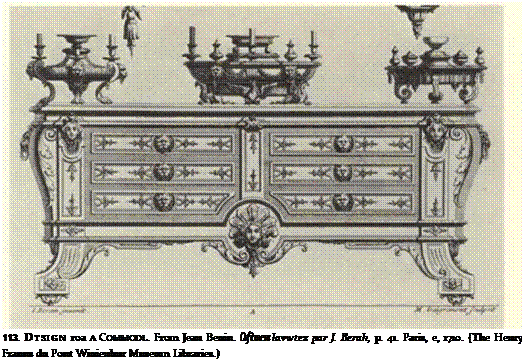
England continually responded to French developments in furniture design. By die mid-eighteenth century French cabinetmakers had refined the massive, rectilinear Boullc style mto the delicate curvilinear furniture called Louis XV, a development soon adopted in England. A commode designed by William Vile’s partner, John Cobb, in 177г. is a virtual copy of contemporary French furniture (fig. 117)- Called French commodes in England, furniture of this type copied the French style with long, slender legs, flaring comers, and a serpentine and bombe front bulging in three dimensions. Although Cobb overlaid the Louis XV style carcass with a veneer in die neoclassical style, the design source is profoundly French.

Designs for similar commodes were available to Bostonians. The Direct or includes a number of plates in all dirce editions і ilusi rating French commodes that vary from direct copies of French furniture to heavily anglicized chests of drawers (fig. nS). No variation of style was ever adopted in Boston. Whether the methods of construction were beyond the capabilities of die Boston cabinetmakers or whether the design itself failed to awaken a response in Bostonians is dilFicult, if not impossible, to determine. All that can be said is that a number of choices for bombe cascpicccs were available to Bostonians, yet they continually chose one variety.

